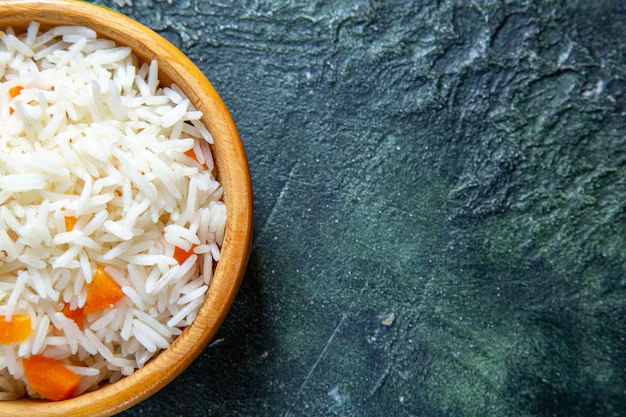How Long Does Rice Really Last in Your Refrigerator? Exploring Safe and Smart Food Storage Practices
Imagine you cooked a large pot of rice for dinner, and there is more than enough left over. You might wonder, "How long can rice last in the refrigerator?" Given the universal love for rice across cultures, understanding how to store it safely is crucial, not only for maintaining its taste and texture but also for health reasons. Let's explore how to make the most of your leftover rice while keeping it safe and delicious for future meals.
🕰️ Understanding Rice Shelf Life in the Refrigerator
The Basics of Rice Storage
Rice is a staple food with a relatively long shelf life when stored properly. However, once cooked, rice's shelf life significantly decreases due to potential bacterial growth. Cooked rice can typically last in the refrigerator for about 3 to 4 days. Ensuring your rice remains safe to eat involves not just knowing how long it can last but understanding the best ways to store it.
Factors Affecting Rice Shelf Life
Several factors impact the longevity of rice in the fridge:
- Temperature: Rice should be stored at or below 40°F (4°C) to inhibit bacterial multiplication.
- Storage Containers: Airtight containers are essential in preserving freshness and preventing moisture or contaminants from entering.
- Moisture Content: Excess moisture can foster bacterial growth, so rice should be cooled and stored dry.
- Time of Storage: The sooner rice is stored after cooking, the better, ideally within two hours.
🥡 Best Practices for Storing Rice Safely
Let's delve into some practical tips you can implement to ensure your rice lasts as long as possible and remains safe to consume.
Cooling and Storing Rice Promptly
Once cooked, it's essential to cool rice quickly to prevent bacterial growth. Here’s how you can do it effectively:
- Spread it out: Spread the rice in a thin layer on a baking sheet to cool it rapidly.
- Refrigerate Fast: Transfer the cooled rice into an airtight container and refrigerate promptly.
Choosing the Right Container
Storing rice in the right container is crucial for extending its shelf life:
- Airtight Containers: Use containers that are sealed tightly. This helps in keeping moisture and air out, crucial factors in prolonging rice freshness.
- Glass or BPA-free Plastic: Consider using glass or BPA-free containers that do not leach chemicals.
Reheating Tips for Safety and Flavor
When you're ready to eat your stored rice, reheating it properly ensures both safety and a good taste experience:
- Reheat Thoroughly: Always ensure rice is heated evenly and thoroughly until piping hot, steaming throughout.
- Avoid Multiple Heatings: Only reheat rice once. Continuous heating and cooling can increase the risk of spoilage and bacterial growth.
🌾 Understanding Types of Rice and Their Storage
Different types of rice might require slightly different storage considerations.
White vs. Brown Rice
- White Rice: Has a longer shelf life due to fewer natural oils.
- Brown Rice: Tends to spoil faster because it retains natural oils.
Specialty Rice Varieties
- Jasmine and Basmati: Follow standard storage guidelines, but appreciate that their aromatic qualities can diminish faster when kept too long.
- Wild Rice: Although not a true rice, it has a slightly different texture and should also be stored in covered containers promptly after cooking.
⚠️ Detecting Spoilage in Rice
Consume your rice with confidence by recognizing signs of spoilage:
- Off Odor: A sour or musty smell indicates spoilage.
- Texture Changes: A slimy or excessively hard texture can mean the rice should be discarded.
- Coloration: Any discoloration or visible mold growth means it's time to throw it out.
📝 Quick Reference Summary
Here are some practical tips for storing and using leftover rice effectively:
| Tip Category | Recommendations |
|---|---|
| Cooling | Spread rice to cool quickly. Refrigerate within two hours to prevent bacteria. |
| Storage | Use airtight containers to maintain freshness and avoid contaminants. |
| Shelf Life | Consume refrigerated rice within 3 to 4 days. |
| Reheating | Heat thoroughly until steaming. Reheat only once. |
| Spoilage Signs | Discard if it smells sour, appears discolored, or feels slimy. |
🍜 Creative Ways to Use Leftover Rice
Aside from simple reheating, leftover rice provides opportunities for culinary creativity:
- Fried Rice: Turn your cold rice into a quick and tasty fried rice with vegetables and protein of your choice.
- Rice Puddings: Sweeten your rice and serve as a comforting dessert with milk, sugar, and spices.
- Stuffed Vegetables: Use your rice as a base for stuffing in peppers or tomatoes.
📊 Storing Rice with Confidence
Properly storing boiled or cooked rice not only preserves its flavor but ensures that it remains safe for you and your family. By adopting best practices for handling and storing rice, you contribute to reducing food waste and optimizing your kitchen’s efficiency.
Understanding and applying these storage protocols empower you to make informed choices about your food safety. Remember, while rice is a versatile and delightful dish, maintaining vigilant storage habits is critical for your health and culinary satisfaction.
